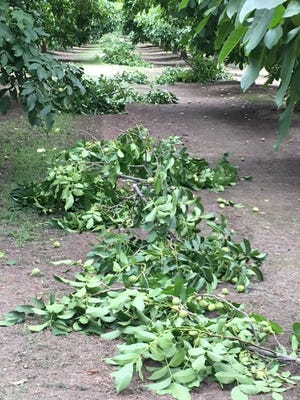July 6, 2016


A removed limb reveals the heavy crop load on this walnut tree at Capay Farms.
“It looks big - really big.”
That’s how Dan Cummings, chief executive officer of Capay Farms, Inc. at Orland, Calif., surmises the size of the walnut crop hanging in the trees following a June 15 inspection of walnut orchards he manages in Butte and Glenn counties.
“We haven’t had a crop that looked this big since 2008,” Cummings says.
“There are a lot of doubles, triples, and even clusters of nuts along with scattered limbs broken by the crop load in all our orchards. We estimate production this year could be up almost 14 percent from our good solid crop last year.”
Following California’s 2015 crop, which likely will total a record-high 602,000 short tons once the final figures are in, walnut prices nose-dived. This, in addition to the unsold walnut kernels still in warehouses, means a big California crop this year doesn’t bode well for a quick upturn in grower prices.
“A more modest crop would probably be more favorable to the industry,” Cummings admits. “But, the market seems to be finding a floor and starting to rebound and that’s a cause for encouragement.”
About 95 percent of his acreage is planted to the Chandler and Howard varieties. Hartley and Scharsch Franquette account for the rest.
Cummings attributes this year’s heavy crop load in his orchards, in part, to more rain this past winter compared to the previous three winters.
And, unlike last year, when most of the winter rain was concentrated in two major events, this time the rains were more evenly spaced throughout the winter. He says the roots were well supplied with water and leached out accumulated toxic salts.
Also, favorable weather conditions during bloom apparently created a good overlap of flowering and catkin emergence, plus an ample supply of pollen for more production. Crop development was further enhanced by the lack of north winds which can dry out the flowers.
Cummings adds the crop has benefited from very light insect and disease pressures.

Limbs removed at Capay Farms due to this year’s large walnut crop load.
Meanwhile, limbs in his orchard continue to sag and knuckle over as the nuts grow larger and heavier. This increases the risk of limb breakage if the winds pick up. Crews with pruning loppers have walked the tree rows cutting off the ends of limbs, as needed, to reduce leverage on susceptible limbs and lower the risk of limbs snapping.
“We seldom do preemptive tipping and have never done as much as we have this season,” Cummings says. “By the time we’re done, we’ll probably have tipped about 85 percent of our acreage.”
Although he’s encouraged by how this year’s crop is developing quality wise, Cummings is concerned whether the trees will produce enough large- and jumbo-sized nuts to meet the strong in-shell demand from buyers overseas. Cummings will have a better handle on this once harvest begins in September and he examines the first few loads of walnuts.
Meanwhile, sunburn is always a threat to kernel quality, especially considering the high market premium on light-colored kernels. However, he says this risk is rising as limbs continue to sag under the weight of the crop, exposing more nuts to damaging sunlight.
Rather than spraying his trees with the sunscreen material Surround, an organic white clay powder, Cummings irrigates his trees more frequently for shorter periods of time.
He says, “This keeps the soil profile fully charged without creating anaerobic conditions that can damage roots and lead to disease.”
Although some of his fields receive surface water, most are irrigated with well water. Over the last four years, Cummings had had enough water to get by yet the prospect of running out has been a constant worry.
This changed this year. Groundwater levels in his orchards have stabilized and even risen. Plus, surface water is available at a much lower cost to offset any well water shortfalls.
Cummings says, “This year, water isn’t the first thing I think about when I wake up in the morning. That’s a welcome relief.”
You May Also Like




